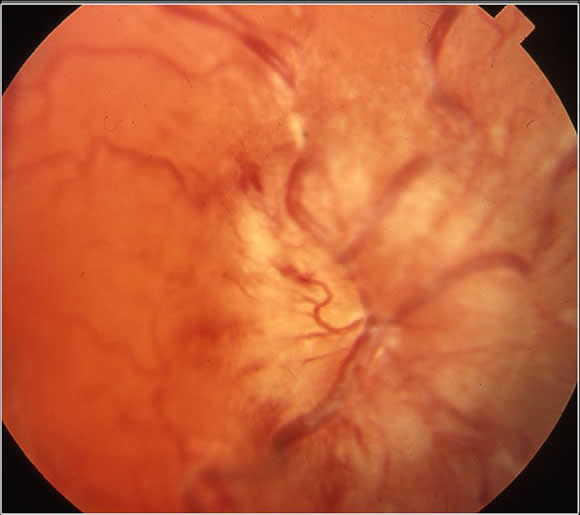The clinical presentation of germ cell tumors depends on:
- Tumor location and extent
- Tumor size
- Patient age
Signs and Symptoms in Pineal tumors:
| Problem |
Signs and symptoms |
| Raised Intracranial Pressure |
Common
Often due to the compression of the Sylvian aqueduct by the tumor
Increased intracranial pressure causes:
- Headache (worse in morning)
- Nausea and vomiting
- On examination papilledema

Can be treated by:
- Third ventriculostomy
- Ventriculoperitoneal shunting (may have risk of dissemination with this)
|
| Visual problems |
Pineal gland is very close to the pretectum - eye symptoms are common
The pretectum:
- Includes the ocular motor centre and pupillary control centre
- Between the thalamus and the midbrain
- Responsible for mediating vertical eye movements
Problems with the visual pathways in pineal tumors:
- Accommodation deficiency
- Oculomotor nerve palsy
- Failure of downward gaze
- Visual field disturbance (mass effect post chiasm)
- Lid retraction (midbrain dysfunction)
- Pupillary abnormality
Classic problem with Pineal tumor:
- Parinaud's Syndrome results in several different visual deficits which include:
- paralysis of upward gaze
- reduced pupillary reflexes to light
- convergence paresis
|
| Cerebellar signs |
- Gait abnormalities, unsteadiness and frequent falls
- Due to pressure on cerebellar peduncles
|
| Endocrine deficits |
Associated with germinomas and hypothalamic lesions
Common deficits associated with germinoma:
Other secondary neuroendocrine deficits:
- Include hypopituitarism, growth failure, and elevated hCG or LH level.
- Precocious puberty
- Far less common to have secondary neuroendocrine deficits with non-germinoma germ cell tumors.
- Choriocarcinoma can be associated with sexual precocity (also may have an increase in CSF concentrations of hCG and LH).
|
| Intracranial hemorrhage |
Rare but a well-documented side effect of pineal tumors:
- Occurs in tumors of various histological subtypes as well as in non-neoplastic masses.
- Bleeding may cause pineal apoplexy or subarachnoid hemorrhage.
- Massive hemorrhage into choriocarcinomas and endodermal sinus tumors is most frequent.
- Tumors of the pineal parenchyma are also very vascular.
- Repeated subarachnoid hemorrhage is associated with germinomas and pineocytomas.
|
| Non-specific neurologic deficits |
- Diplopia
- Seizures
- Choreoathetosis
- Ophthalmoplegia
- Dementia
- Psychosis
|
Non-germinoma germ cell tumors tend to have localized clinical features due to pineal mass effect.
Back to top
Next


